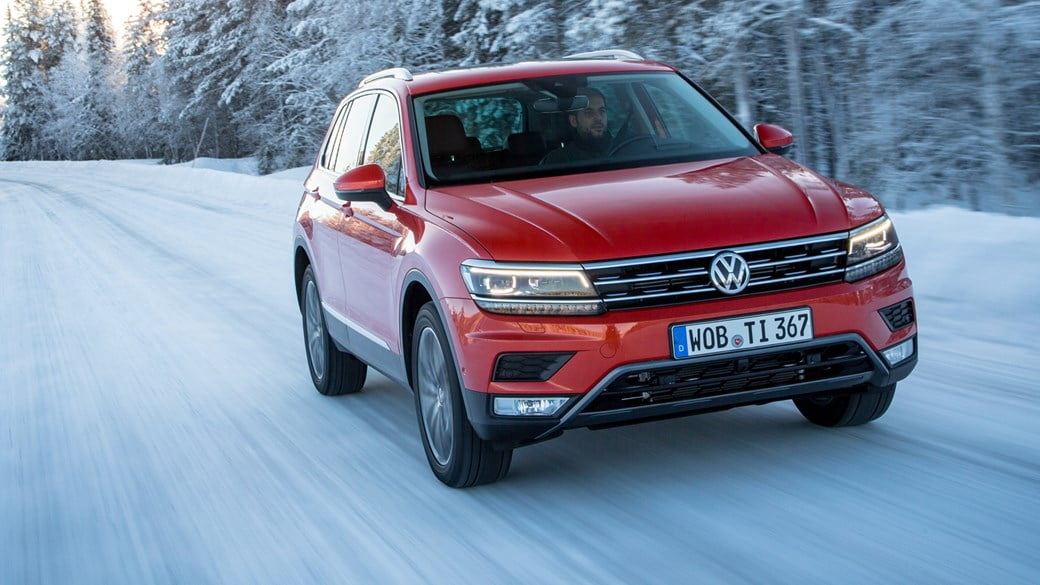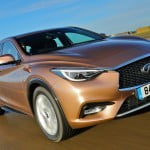
The old VW Tiguan has gone out with a bang. Despite having been around since 2008 (usually seen ahead of a caravan or horsebox), 2015 year was its strongest-selling year ever – despite a brand-new version in the pipeline: this one. No pressure, then.
We’ve been driving a pre-production car in the extreme cold of Sweden’s Arvidsjaur testing facility to find out what VW’s done to keep it ahead of an ever-growing horde of SUV rivals.
Updated looks for the second-gen Tiguan
It’s hard to tell whether the new Volkswagen Tiguan looks more like a Golf or a Passat from the outside – it certainly takes more than a few cues from both.
The second-generation Tiguan has been built on the same platform as those two, enabling a more spacious cabin for its occupants as well as various economies of scale benefits for VW.
New VW platform cuts weight, boosts space
This is the first SUV to come out of Wolfsburg on the modular transverse matrix ‘MQB’ platform (think Golf, TT, Octavia and many more). It’s not only larger than the previous car but lighter too, reputedly shedding more than 50kg overall.
It’s also bigger on the inside, with ‘generous’ legroom in the back thanks to an additional 77mm between the wheels. You also get a larger boot – 145 litres extra – taking the loadspace to 615/1655 litres (back seats up/down).
Driving dynamics engineer Jurgen Putzschler said the inherently stiffer platform also meant a softer suspension setup could be used without compromising the handling. The ride certainly felt smooth during our test drive, albeit over several inches of soft snow, and body control on the handling circuit was hard to fault.
2016 VW Tiguan engines and pricing
Previously you’d only see a Tiguan filling up from a black pump after petrol power – which accounted for just 3% of sales – was unceremoniously dropped. The new Tiguan will go on sale in Europe with eight engines in total (a 50/50 fuel split) and VW reckons petrol will make up 5-10% of the mix this time around.
Petrol or not, they’re all turbocharged and directly injected, with the majority of the range expected to be made available in the UK. From April you can drive away in a 2.0-litre TDI with 148bhp or a 2.0-litre TSI with 178bhp – both punchy and refined with the diesel offering a strong midrange.
The 237bhp bi-turbo diesel – as used in the fastest Passat – will arrive later this year and should give the Tiguan enough pace to seriously reorganise the interior of your caravan.
If that concept excites you then you’ll be sad to hear there are no plans for a properly hot version, and according to VW electrification is a ‘high priority’. In other words, you’re more likely to see a Tiguan with GTE badges than GTI, or even R.
Other engines will be available to order from the start too, and we’ll find out which we’re getting from the continent’s list of 1.4 and 2.0-litre petrols (123bhp, 148bhp, and 217ps), and 2.0-litre diesels (113bhp and 187bhp) closer to the UK launch.
Likewise the official economy figures – for now we’ll have to make do with the knowledge that the new range is up to 24% more efficient than before. Sounds promising.
Expect a starting price around £23,000, with manual gearboxes on the lower-powered engines and standard-fit dual-clutch automatics for the higher outputs. The dual-clutch gearbox will also be offered on some mid-range trims as a cost option.
New trims and tech for 2016 VW Tiguan
Bringing the Tiguan more in line with the rest of the VW range means it loses the hard plastic and van-like circular vents of old, and adopts the crisp lines and metal framing of the current Golf. It’s a nicer place to sit, especially for the driver, towards whom the majority of controls are oriented.
As well as being better looking it’s also more functional; our test cars were fitted with the latest 8-inch infotainment system (called Discover Navigation Pro) which features MirrorLink, Apple CarPlay and Android Auto, adapting smartphones’ functions directly to the screen.
We also had digital dials displayed on a 12.3-in ‘Active Info’ display, with an analogue-looking rev counter and speedometer, plus a customisable centre area that can toggle between sat-nav maps and media information, among other functions. On top of all this, quite literally, is a head-up display projected onto a plastic screen above the dash.
Off-road abilities that should match the looks
All-wheel-drive models (standard on four of the engines, optional on two, and not available on the base trims) use the fifth-generation Haldex system, which can send nearly 100% of torque to the rear axle when it detects a loss of grip.
You also get VW’s ‘XDS+’ system, which brakes the inside wheels when cornering to help tighten your line around a corner. 4wd versions benefit further from an additional 11mm of ground clearance over 2wd models.
If there are any particularly high kerbs outside the school gates, there’s also an option to increase the front approach angle to 25.6 degrees instead of the standard 18.3, a bit like the ‘Escape’ version of the old car.
VW’s new 4Motion Active Control tailors different parameters (such as the dampers, drivetrain, steering and even cornering lights) for different driving conditions, including road, snow and off road via a rotary toggle next to the gear shift.
We tested each of these on the snow and ice tracks at VW’s Swedish winter testing facility, equipped with some grippy Nordic-spec rubber, and our Tiguan clung on to the slippery surface like bacon to a travel saucepan. Only in off-road mode could the stability systems be completely disabled, allowing for some very un-Caravan Club-like oversteer.
New Tiguan should be safer on the road, too
All cars now come with a roster of active safety tech, including low-speed automatic emergency braking, lane keeping assist, a recognition system that keeps an eye out for pedestrians and cyclists, and automatic post-collision braking. You also get seven airbags, including one for the driver’s knees.
More rivals to face and big shoes to fill
The outgoing Tiguan is VW’s third best-seller in the UK, behind the Golf and the Polo, and 2.8 million have found homes worldwide. Can the new car build on its success and fend off competition from the likes of the BMW X1, Honda HR-V and Ford Kuga? We’ll find out when we drive the finished product back on terra firma in spring.
[“source-carmagazine”]





